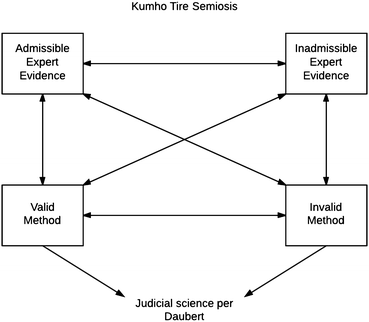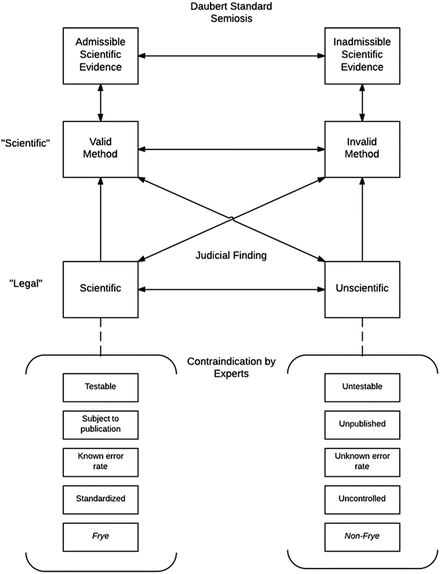Without Authority: The Battle of Experts, the Caricature of a Discourse and the Failure of Scientific Evidence

Admissible scientific evidence is sourced through its establishment in the field, outside the legal arena. Insufficiently established evidence is likewise inadmissible— a showing of a theory’s unpopularity by one side can be used to contradict such an assertion by another. Crucial to the legal semiotic implication of scientific material under the Frye standard is that it is very nearly expressly semiotic. The judge is explicitly charged with evaluating material foreign to the legal discourse, knowing its alienage, and interpreting its representation prior to a legal construction. By indicating that it cedes the claim of authority and its evaluation to the viewpoint of the community, the court in Frye constructs, for those operating within its bounds, the illusion of a layer of legal information that is not legal, but “scientific”. That this is illusory, is a matter of course; instead, the content of the “scientific” space is legal, but held separate from the legal—because the standard “showing” acceptance for the legal purpose exists outside the legal space, yet is introduced by legal practitioners. Without a true authority, each side is welcome to assert the acceptance and truth of the scientific without meaningful interference from “above”, in legal authority openly ceded, or “below”, in the scientific discourse, which cannot enter the legal space absent the interpretation and presentation of counsel. Thus is presented the grand stereotype: two attorneys produce two experts, each seeking to satisfy the legal standard of “general acceptance”. The battle of experts commences, but its tools are not of method or reason, but of authority: the competent lawyer does not seek to prove the validity of the evidence at issue, but to demonstrate that it wins a popularity contest in its field— bearing always in mind that it is not the scientific evaluator, but the judge, who selects the victor. Although the legal authority appears to be vested in the scientific community, the reality is that such authority cannot escape the positive and final representation of a legal standard. Despite its problems, Frye was a success in one sense: its authors acknowledged the intractable nature of the scientific-legal meaning problems they had created. The negative space that Frye invited reflects an unavoidable tension in the investment of scientific authority with legal meaning. This tension is addressed differently in later cases which purport to overturn the general acceptance standard and address its problems, but which instead incorporate Frye, and its contradictions, in increasingly Byzantine forms.
The issues first presented in Frye would be addressed again in the present era, first in the form of Rule 702 of the Federal Rules of Evidence (henceforth the FRE), and second in the “Daubert trilogy”, the primary body of case-law interpreting the Rule. This series of three cases are taught as the summary of contemporary American expert testimony law; students (and therefore attorneys) not intending to specialize in the area understand little beyond them. The Daubert trilogy is therefore a symbol invoked to represent the whole of expert witness law (for the Daubert Standard is often represented as a criterion test of representation, despite the fact that it possesses no explanatory power). Although the Frye standard remains in effect in some state jurisdictions, the interplay of the FRE and the trilogy have produced a new paradigm, one in which the discourse of the expert is no longer given credence beyond their adherence to the formalities of the legal standard, which redefines the scientific (or other expert knowledge) representation in a legal context. At the same time, these formal requirements are frequently no shield to the obscurantism and rhetoric of conflicted accounts that naturally emerge from 1) a scientific discourse founded on the active maintenance of methodological criticism and uncertainty, and 2) the instrumental abuse of the standard’s loosely held criteria by witness and attorney alike. As a consequence, the modern Daubert standard has produced the worst of both worlds: in seeking to render more effective the purposes of the Frye decision, have produced a new world in which the lawyer and advocate both pursue the ends of their respective discourse, and arrive at neither.
Daubert, Anarchic Authority and the Destruction of the Scientific Witness
Daubert v. Merrell Dow Pharmaceuticals was not solely an attempt to deal with the problems of establishing meaningful authority that were made evident by the response to Frye 4. The decision was principally an attempt to unify the law upon the text of Rule 702, and to articulate the rule in a manner that would render future adjudication of expert materials consistent5. This was no easy task; given the shallow language of Rule 702 as initially developed:

The term “qualified” in the rule was patently inadequate to the use it was called for in the free-for-all that had emerged since the Frye decision, the Federal Rules seemed void of meaning without an interpretant context. Without guidance regarding what qualified an established or novel theory, or what forms of “knowledge, skill, experience, training or education” were sufficient in a specific instance, attorneys and officials alike struggled to determine how the rule changed the standards they had previously applied—many were of the opinion that Rule 702 simply restated the previous Frye standard, despite the lack of authority it presented. The Supreme Court in Daubert thus sought gave the rule meaning as a new duty of judicial practice, emphasizing the duty of the judge as evaluator of expert evidence and producing a standard for that adjudicative task. Where Frye had suggested the ceding of authority to the scientific speaker, the Daubert standard pursued the opposite—a complete seizure of the authority of scientific evidence by the court itself. Central to the Daubert decision is the construction of the trial judge as “gatekeeper” of scientific credibility, the final evaluator of scientific knowledge from outside the legal field, and therefore the creator of legal precedent built upon that incorporation. The Daubert standard, before all else, requires the trial judge in their evaluation of Rule 702 scientific knowledge to determine whether “the reasoning or methodology underlying the testimony is scientifically valid…We are confident that federal judges possess the capacity to undertake this review.”7 The tension first present in Frye, already subject to open abuse, is thus reconstituted in a manner which, in attempting to address the preexisting conflict of meaning, instead only serves to develop and obscure the problem previously extant. The opinion itself emphasizes the difficulty of establishing a coherent, textual standard for the judge’s newfound task: “Many factors will bear on the inquiry, and we do not presume to set out a definitive checklist or test. But some general observations are appropriate.”8
If scientific, technical or otherwise specialized knowledge will assist the trier of fact to understand the evidence or to determine a fact in issue, a witness qualified as an expert by knowledge, skill, experience,, training or education, may testify thereto in the form of an opinion or otherwise.6

To provide even a loose guide to what is acceptable, the standard becomes one of methodological validity as a means to accurate science. As a result, the factors listed by the court are a series of legal criteria prescribed to scientific material, claimed as a description of a scientific-legal standard. The wide range of the factors described in the Daubert decision are not intended to be exclusive, but their scattered origins and representation compared to the binary standard they are meant to serve articulate the uncertainty of the law in the scientific space. First, citing to the work of the philosopher of science Karl Popper, the court finds that scientific material should be falsifiable and testable. Second, they find that, descriptively, scientific material is subject to peer review and publication. Third and fourth, scientific material is evaluated by the presence or absence of a known rate of error and methodological controls—a reinscription of science in terms of its ability to serve as a basis for belief in a legal outcome. Finally, and most seriously, the justices invite the reintroduction of the Frye general acceptance criterion as one factor proving that the evidence is scientific, therefore methodologically sound, therefore scientific evidence. The incorporation of Frye is particularly significant, in that it underscores the fundamental shift in the meaning of the whole standard. In attempting to resolve the lack of clear authority created by Frye, the Supreme Court deems the admissibility of scientific evidence a judicial duty. At the same time, however, the terms and meanings the court presents as the standard of this judicial decision are “scientific”. As in Frye, the judge is invited to choose among meanings he is invited—and instructed—not to understand. The problems of contradiction in the Daubert factors test therefore extend past the uncertainty of any more anodyne issue of linguistic uncertainty in, for example, a “reasonable person” standard, or any other source of initial textual ambiguity. Here the loss of meaning occurs from both directions at once.